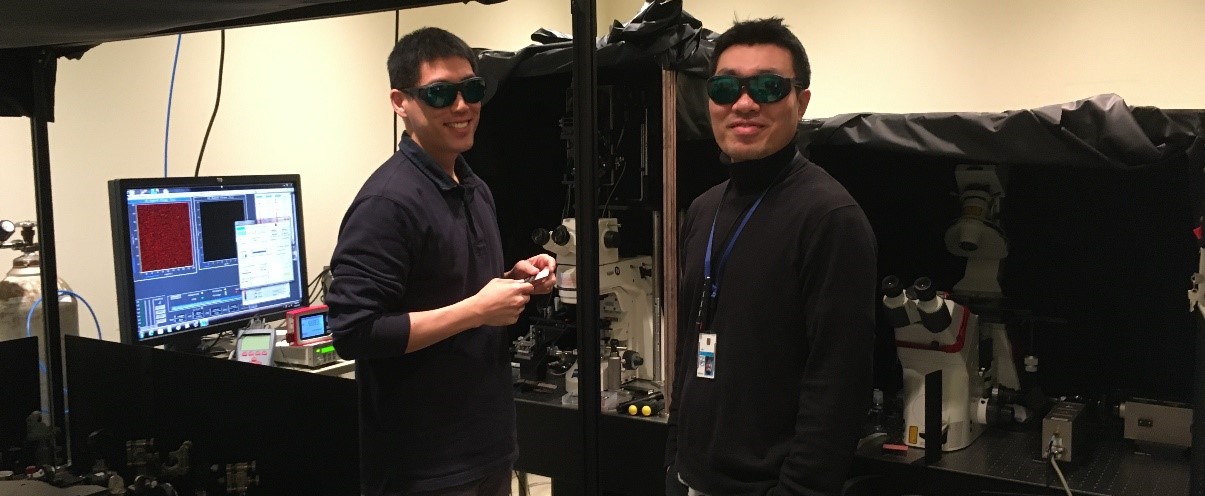Laboratory of Biophotonics and Quantum Biology


Contact Information
- Office: 1 301.496.9288
- Fax: 1 301.480.0466
-
Mailing Address
National Institute on Alcohol Abuse and Alcoholism
5625 Fishers Lane
Room TS-06F:MSC 9411
Bethesda , MD 20892
Overview of the Lab
The goal of the Laboratory of Biophotonics and Quantum Biology (LBQB) is to develop advanced imaging and spectroscopy techniques for studying protein-protein interaction under physiological conditions and for developing second-generation biosensors. We are particularly interested in developing new tools and approaches using fluorescent proteins for studying proteins that modulate synaptic behavior. Techniques used in LBQB include two-photon laser scanning confocal microscopy, fiber photometry, FRET microscopy, fluorescence lifetime microscopy (FLIM), time-resolved anisotropy, fluorescence correlation spectroscopy (FCS) and photon antibunching microscopy. Currently the two main projects in the lab are focused on 1. Using light to probe dynamic conformational changes in the calcium-calmodulin dependent protein kinase-II holoenzyme in response to activation and subsequent interaction with T-site ligands, and 2. To understand how the structure of fluorescent protein dimers allow then to form coherent excitonic interactions under hot and wet physiological conditions.
In cells, proteins rarely function in isolation; typically they act together to form assemblies that mediate cellular processes. Considering how ubiquitous protein complexes are, as well as the vast array of functions they perform, it is no surprise that many human diseases arise in part from inappropriate protein interaction. A major obstacle to understanding the basis of these diseases is the paucity of robust methods for studying both normal and abnormal protein interactions under physiological conditions. LBQB has been developing new forms of microscopy as well as spectroscopy through fiber optics to monitor protein interactions inside living cells and animals. These approaches are based primarily on Förster Resonance Energy Transfer (FRET) and Fluctuation Correlation Spectroscopy (FCS). We are specifically interested in the interactions of synaptic proteins that are involved in regulating memory, behavior, and addiction, and our long-term goal is to apply these photonic approaches to facilitate the identification of drugs that can target and specifically correct abnormal protein interactions inside cells. Our research interests reside at the intersection of physics, bioengineering, and neurobiology. The technology that LBQB is developing will provide tools for delineating the detailed steps in protein complex conformational changes, provide a means of rapidly identification specific sites of protein interaction in complexes, help decipher which protein partners actually interact within large assemblies of proteins, and provide the means for confirming if a specific interaction is in fact occurring under physiological conditions, even when that interaction occurs deep within the brain of a living and behaving mouse.
Lab Members




Selected Publications
Search for all publications from the Vogel Lab on PubMed
Kim, Y., and S. S. Vogel (2020). "Measuring two-photon microscopy ultrafast laser pulse duration at the sample plane using time-correlated single-photon counting." J Biomed Opt 25(1): 1-9.
Kim, Y., H. L. Puhl, 3rd, E. Chen, G. H. Taumoefolau, T. A. Nguyen, D. S. Kliger, P. S. Blank and S. S. Vogel (2019). "VenusA206 Dimers Behave Coherently at Room Temperature." Biophys J 116(10): 1918-1930.
Algar, W. R., N. Hildebrandt, S. S. Vogel and I. L. Medintz (2019). "FRET as a biomolecular research tool - understanding its potential while avoiding pitfalls." Nat Methods 16(9): 815-829.
Nguyen, T. A., H. L. Puhl, 3rd, A. K. Pham and S. S. Vogel (2018). "Auto-FPFA: An Automated Microscope for Characterizing Genetically Encoded Biosensors." Sci Rep 8(1): 7374.
Sarkar, P., K. A. Davis, H. L. Puhl, III, J. V. Veetil, T. A. Nguyen and S. S. Vogel (2017). "Deciphering CaMKII Multimerization Using Fluorescence Correlation Spectroscopy and Homo-FRET Analysis." Biophysical Journal 112(6): 1270-1281.

